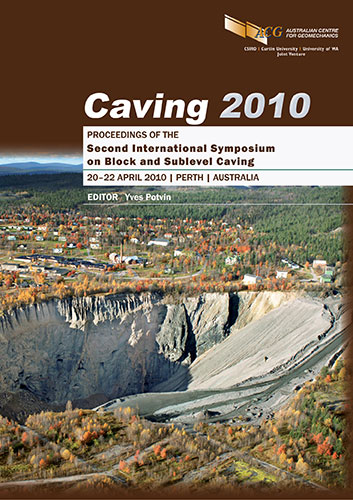Understanding the flow of caved ore and its influence on ore recoveries and dilution in a block cave

|
Authors: Heslop, TG |
DOI https://doi.org/10.36487/ACG_rep/1002_37_Heslop
Cite As:
Heslop, TG 2010, 'Understanding the flow of caved ore and its influence on ore recoveries and dilution in a block cave', in Y Potvin (ed.), Caving 2010: Proceedings of the Second International Symposium on Block and Sublevel Caving, Australian Centre for Geomechanics, Perth, pp. 539-551, https://doi.org/10.36487/ACG_rep/1002_37_Heslop
Abstract:
Ore recovery and dilution are critical issues in the economic projections of block cave viability and ultimately the profits made by the mine. In planning and operating caving mines, numerical modelling techniques are increasingly used to model material flows in the feasibility and planning phases of the mine life, and to monitor draw down in the production phase. Not only are numerical modelling results strongly influenced by the assumed boundary conditions and material flow characteristics, the modelling techniques have limitations and may not reliably replicate the actual conditions in the cave. These include variations in material flow characteristics and the changes in these as the draw progresses. Any errors or biases in these assumptions can have a huge effect on economic projections and ultimately in the actual profitability of the mine. A sound understanding of the dynamic nature of draw mechanics is essential in both the appraisal of modelling results and in the formulation of draw control strategies for maximum recoveries. In this paper the writer reviews material flow theories, the factors that influence the nature and direction of draw and discusses strategies that could assist in reducing dilution ingress from both theoretical and practical points of view. Recent experience and lessons from producing mines, marker migration monitoring and model tests are drawn on for this assessment.
References:
Alfaro, A. and Saavedra, J. (2004) Predictive models for gravitational flow, in Proceedings MassMin 2004, A. Karzulovic and M. Alvaro (eds), 22–25 August, Santiago, Chile, Instituto de Ingenieros de Chile, Santiago
pp. 179–184.
Bell, N.J.W. (1992) Technical note on M/4e draw markers, African Associated Mines, Group report.
Brown, E.T. (2003) Block Caving Geomechanics, JKMRC Monograph Series on Mining and Mineral Processing 3, Julius Kruttschnitt Mineral Research Centre, University of Queensland, Brisbane, 515 p.
Bull, G. and Page, C.H. (2000) Sublevel Caving – Today’s dependable low cost ‘ore factory’, in Proceedings MassMin 2000, G. Chitombo (ed), 29 October to 2 November 2000, Brisbane, Australia, Australasian Institute of Mining and Metallurgy, Melbourne, pp. 537–556.
Castro, R.L. (2007) Study of the mechanisms of gravity flow for block caving, Thesis (PhD), University of Queensland, 314 p.
Castro, R.L. Gonzalez, F. and Arancibia, E. (2009) Development of gravity flow model for the evaluation of drawpoint spacing for block/panel caving, Journal of the South African Institute of Mining and Metallurgy, 2009,
pp. 393–400.
Diering, T. (2000) PC-BC: A Block cave Design and Draw Control System, in Proceedings MassMin 2000, G. Chitombo (ed), 29 October to 2 November 2000, Brisbane, Australia, Australasian Institute of Mining and Metallurgy, Melbourne, pp. 469–484.
Guest, A.R. (2007) The difference between interaction and interactive draw, in Proceedings 1st International Symposium on Block and Sub-Level Caving, Journal of the Southern African Institute of Mining and Metallurgy, pp. 123–132.
Gustafsson, P. (1998) Waste rock content variations during gravity flow in sublevel caving – analysis of full scale experiments and numerical simulations, Doctoral Thesis 1998:10, Luleå University of Technology, Luleå, Sweden, 247 p.
Heslop, T.G. (1983) The Application of Interactive Draw Theory to Draw Control Practice in Large Chrysotile Asbestos Mines, Mining and Metallurgical Operations in Zimbabwe, June 1983, Harare: Institution of Mining and Metallurgy Zimbabwe Section, 1983, Vol. III, pp. 290–313.
Janelid, I. and Kvapil, R. (1966) Sublevel caving, International Journal of Rock Mechanics and Mining Science, Pergamon Press, Vol. 3, pp. 129–153.
Jolley, D. (1968) Computer simulations of the movement of ore and waste in an underground mining pillar, Canadian Institute Mining Metallurgy Transactions, Vol. 61, No. 675, pp. 854–859.
Laubscher, D. (1994) Cave mining – the state of the art, Journal of the South African Institute of Mining and Metallurgy, pp. 279–293.
Laubscher, D. (2000) Block Caving Manual, International Caving Study Report, JKMRC and Itasca Consulting Group Inc., Brisbane.
Marano, G. (1980) The interaction between adjoining draw points in free flowing materials and its application to mining, Chamber of Mines Journal, Zimbabwe Chamber of Mines, Harare, Zimbabwe, Vol. 22, No. 5.
McNicholas, F.S., Rogers, V.C. and Walker, S. (1946) An experimental study of caving and drawing large orebodies, American Institute of Mining, Metallurgical and Petroleum Engineers Transactions, Chicago meeting, February, Vol. 163, pp. 156–197.
Power, G.R. (2004) Modelling granular flow in caving mines: large scale physical modelling and full scale experiments, Thesis (PhD), University of Queensland, 283 p.
Susaeta, A. (2004a) Theory of gravity flow (Part 1), in Proceedings MassMin 2004, A. Karzulovic and M. Alvaro (eds), 22–25 August, Santiago, Chile, Instituto de Ingenieros de Chile, Santiago, pp. 167–172.
Susaeta, A. (2004b) Theory of gravity flow (Part 2), in Proceedings MassMin 2004, A. Karzulovic and M. Alvaro (eds), 22–25 August, Santiago, Chile, Instituto de Ingenieros de Chile, Santiago, pp. 173–178.
Szwedzicki, T. and Cooper, R. (2007) Ore flow and fragmentation at Perseverance Mine, in Proceedings 1st International Symposium on Block and Sub-Level Caving, Southern African Institute of Mining and Metallurgy, pp. 133–146.
Yengi, L.I. (1981) Analysis of bulk flow of materials under gravity caving process, Part 2 Theoretical and physical modelling of gravity flow of broken rock, Colorado School of Mines Quarterly, Vol. 75, No. 3.
© Copyright 2025, Australian Centre for Geomechanics (ACG), The University of Western Australia. All rights reserved.
View copyright/legal information
Please direct any queries or error reports to repository-acg@uwa.edu.au
View copyright/legal information
Please direct any queries or error reports to repository-acg@uwa.edu.au